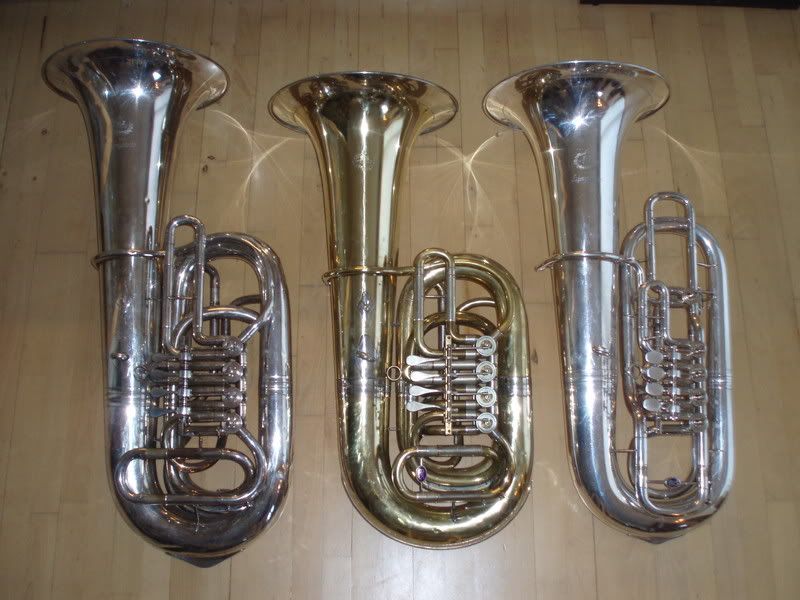I here show a picture of my 3 B&S tubas (all extremely well playing horns). Left to right they are:
B&S Symphonie 4v BBb
B&S 4v CC
B&S Symphonie 5v F





Nice looking horns! Thanks for sharing the images!Søren wrote:Just to state what many of us take for granted. The topline of instruments of B&S in the good old days were the "Symphonie" line. I have been fortunate enough to play a number of these, and I even own 2 specimens. The 3 different Symphonie F tubas I have played was all different. I guess that they changed the design slightly as the years went on. I have seen the same change on some of the normal B&S/Weltklang BBb and Eb tubas. The most obvious change for the BBb and Eb tubas are that the tuning slide went from horizontal to vertical at some point.
I here show a picture of my 3 B&S tubas (all extremely well playing horns). Left to right they are:
B&S Symphonie 4v BBb
B&S 4v CC
B&S Symphonie 5v F

Again, this is some great information. I'm trying to collate all this material into an organized narrative about the B&S phenomenon. I appreciate that you are willing to share such wonderful stories.imperialbari wrote:For me most of the European brass history comes from listening to people in the know. But the brass history can only be understood as a reflection of national and continental history. For reasons not to be repeated here I have experienced post-WWII history at very close range, so I know the historical framework.
Our late TN-friend, Kurt Klingspor, had contacts with a brass museum in Markneukirchen. Sadly it passed totally by me, that Kurt went from very active to terminally ill in a very short time, so I have not taken over that contact. My policy is to let everybody do what they are the best ones doing, so I had seen no reason to work within Kurt’s special field. In the same way Cornucopia and I exist very well together. Keller & Kenton have much better text references than I have. Because I have chosen the free server space of Yahoo, I then can upload photos in very high resolutions and in large numbers, whenever I can get by them.
As I have understood the main repairman (until his death in 1990) of the Danish B&S importer, GDR amateurs had no chance acquiring B&S instruments. These were mainly for export and for professional players.
GDR had 95 or so professional orchestras for a population of 15 or 16 millions. That was way over the average of any western country, but entertainment and holidays were the more gentle factors the GDR regime applied with the goal of keeping away uproars.
The GDR conservatories had a very strict grading system which determined which orchestras students were allowed auditioning for. Only the very best players were allowed getting foreign instruments. The cello players in one East Berlin top orchestra were given top notch foreign strings. Only not the brand they wanted. So a really odd traffic started, when these cellists found a Danish connection. He smuggled the unwanted strings to Copenhagen, where they were considered good value, and then he smuggled the desired brand of strings back to East Berlin.
In other words I don’t think the Sonora brand was for GDR players. They rather played B&S or Weltklang, which are very German terms in their styling.
Klaus
